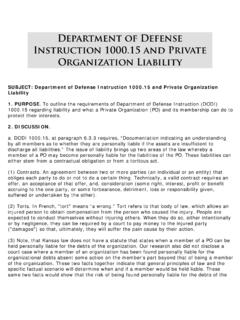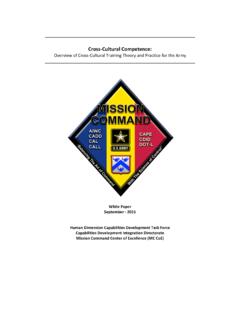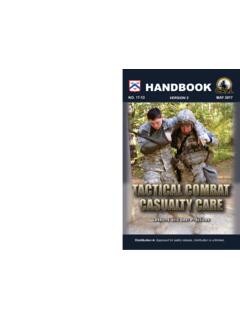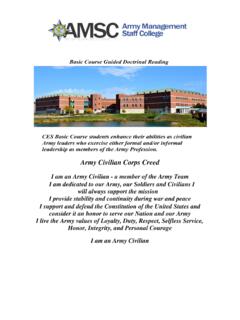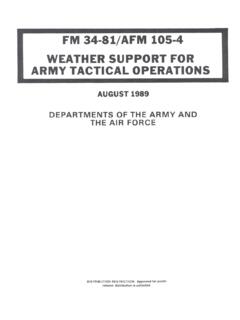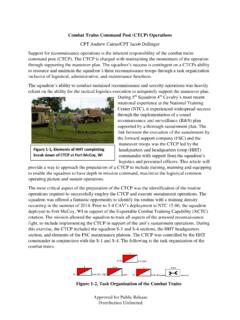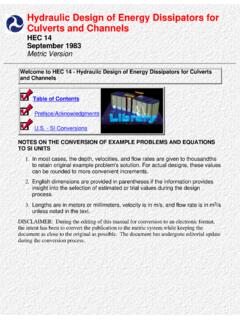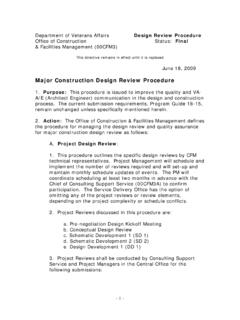Transcription of No. 15-06 - United States Army
1 No. 15-06 MDMP MAR 15 DIGITAL VERSION AVAILABLEA digital version of this CALL publication is available to view, download, or reproduce from the CALL restricted website, < >. Reproduction of this publication is welcomed and highly Access Card (CAC) or army Knowledge Online (AKO) login is required to access the digital DecisionmakingProcessMILITARY DECISIONMAKING PROCESSiiiForewordHistorically, a unit s success is directly related to the ability of the staff to execute the military decisionmaking process (MDMP). Given the increased complexity of today s operational environment and the vast array of mission command systems and processes, integration and synchronization of all activities associated with operations are increasingly derived from deployed units, as well as from trainers at Combat Training Centers (CTCs) over the past decade, indicate a significant loss of unit ability to conduct a detailed MDMP.
2 This lack of planning expertise results in de-synchronized operations, and could ultimately cost the lives of in actual operations and in training at the CTCs, planning time is often extremely limited. In these instances, units often omit steps of the MDMP. Most CTC trainers agree that when time is limited, completely omitting any step of the MDMP is not the solution and often degrades mission success. Combat operations in Iraq and Afghanistan resulted in the use of non-doctrinal story boards in the planning process. This practice lacks the fidelity necessary to provide the commander with decisionmaking information he needs, and can lead to a loss of synchronization during MDMP is a solid model for developing a solution to a problem. However, if the staff conducting the MDMP is unfamiliar with each of the steps, the process can become very complex, and errors committed early in the process become increasingly problematic as planning MDMP facilitates interaction among the commander, staff, and subordinate headquarters throughout the operations process.
3 It provides a structure for the staff to work collectively and produce a coordinated plan. During planning, staff members monitor, track, and aggressively seek information important to their functional areas. They assess how this information affects course of action development and apply it to any recommendations they FOR army LESSONS LEARNEDT here are numerous key doctrinal manuals that address MDMP. This handbook is designed to consolidate much of this doctrine, combined with analysis of observations from recent deployments and CTC rotations, into a single source that is useful to junior leaders as they conduct the MDMP. More detailed study of the MDMP can be accomplished by studying the key doctrinal manuals listed in Chapter 13 of this handbook. vMILITARY DECISIONMAKING PROCESSM ilitary Decisionmaking ProcessTable of ContentsIntroduction1 Chapter 1.
4 army design Methodology3 Chapter 2. Military Decisionmaking Process7 Chapter 3. Receipt of Mission9 Chapter 4. Mission Analysis11 Chapter 5. Course of Action Development27 Chapter 6. Course of Action Analysis39 Chapter 7. Course of Action Comparison59 Chapter 8. Course of Action Approval63 Chapter 9. Assessments65 Chapter 10. Operations Order71 Chapter 11. Rehearsals83 Chapter 12. Terminology97 Chapter 13. References103 Center For army Lessons LearnedDirectorCOL Paul P. ReeseDeputy Division ChiefMr. George J. Mordica IICALL Lead AnalystMr. Jeff BakerCALL Contributing AnalystMr. James CameronProject AnalystMr. Mike Flynn Combined Arms Doctrine DirectorateviCENTER FOR army LESSONS LEARNEDThe Secretary of the army has determined that the publication of this periodical is necessary in the transaction of the public business as required by law of the otherwise stated, whenever the masculine or feminine gender is used, both are : Any publications (other than CALL publications) referenced in this product, such as ARs, FMs, and TMs, must be obtained through your pinpoint distribution DECISIONMAKING PROCESSI ntroduction A good plan violently executed now is better than a perfect plan executed next week.
5 General George S. PattonPlanning is the art and science of understanding a situation, envisioning a desired future, and laying out effective ways of bringing that future about. Planning helps commanders create and communicate a common vision among themselves, their staffs, subordinate commanders, and unified action partners. All planning is based on imperfect knowledge and assumptions about the future. Planning cannot predict exactly what the effects of the operation will be, how enemies will behave, or how civilians will respond to the friendly force or the enemy. Nonetheless, the understanding and learning that occur during the planning process have great value. Planning activities occupy a continuum ranging from conceptual to detailed. On one end of the continuum is conceptual planning.
6 Understanding the operational environment and the problem, determining the operation s end state, establishing objectives, and sequencing the operation in broad terms all illustrate conceptual planning. At the other end of the spectrum is detailed planning. Detailed planning translates the broad operational approach into a complete and practical plan. Detailed planning works out the scheduling, coordination, or technical problems involved with moving, sustaining, synchronizing, and directing the leaders employ three methodologies for planning, determining the appropriate mix based on the scope of the problem and their familiarity with it, the time available, and the availability of a staff. Methodologies that assist commanders and staffs with planning include army design methodology, the military decisionmaking process (MDMP), and troop leading handbook will provide a brief discussion of the army design methodology and how it is integrated with and complements the MDMP, but the focus of this handbook is to provide commanders and their staffs a tool to assist in the understanding and implementation of DECISIONMAKING PROCESSC hapter 1 army design MethodologyThis chapter is designed to give a brief explanation of the army design methodology and how it is integrated with the military decisionmaking process (MDMP).
7 For a more detailed explanation of the army design methodology, refer to ADP 5-0 and ADRP design methodology is a methodology for applying critical and creative thinking to understand, visualize, and describe problems and approaches to solving them (ADRP 5-0). army design methodology is particularly useful as an aid to conceptual planning, but must be integrated with the detailed planning typically associated with the MDMP to produce executable plans. army design methodology entails framing an operational environment, framing a problem, and developing an operational approach to solve the problem. It results in an improved understanding of the operational environment, a problem statement, the initial commander s intent , and an operational approach that serves as the link between conceptual and detailed planning.
8 Based on their understanding gained during the army design methodology, commanders issue planning guidance, to include an operational approach, to guide more detailed planning using the MDMP. Figure 1-1 depicts the general activities of army design methodology. While planners complete some activities before others, the learning generated in one activity may require revisiting the learning derived in another 1-1. Frame the operational environment (ADRP 5-0)4 CENTER FOR army LESSONS LEARNEDF rame the Operational EnvironmentThe commander, members of the staff, subordinate commanders, and unified action partners form a planning team to establish context for describing the problem and developing an operational approach by framing an operational environment. This framing facilitates hypothesizing, or modeling, that focuses on the part of the operational environment under consideration.
9 Framing provides a perspective from which commanders can understand and act on a problem. In framing an operational environment, the planning team focuses on defining, analyzing, and synthesizing the characteristics of the operational and mission variables. Members of the planning team capture their work in an operational environmental frame (using narrative and visual models) that describes and depicts the history, culture, current state, relationships, and future goals of relevant actors in an operational environment. An operational environmental frame consists of two parts the current state of the operational environment and the desired end state of the operational the ProblemA problem is an issue or obstacle that makes it difficult to achieve a desired goal or objective. In the context of operations, an operational problem is the issue or set of issues that impede commanders from achieving their desired end state.
10 Problem framing involves identifying and understanding those issues that impede progress toward the desired end of the planning team frame the problem to ensure that they are solving the right problem, instead of solving symptoms of the problem. Framing the problem involves understanding and isolating the root causes of conflict. The planning team closely examines the symptoms, the underlying tensions, and the root causes of conflict. From this perspective, the planning team can identify the fundamental problem with greater clarity and consider more accurately how to solve it. A technique for framing the problem begins with two basic questions: What is the difference between the current state and the desired state of the operational environment? What is preventing forces from reaching the desired end state?
